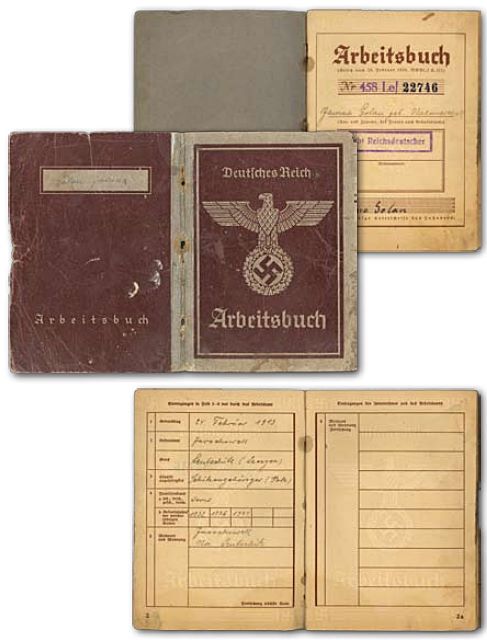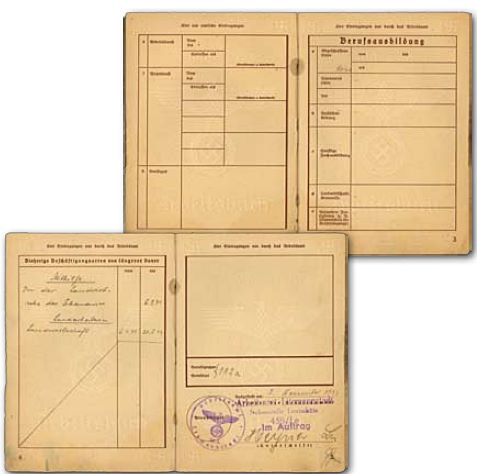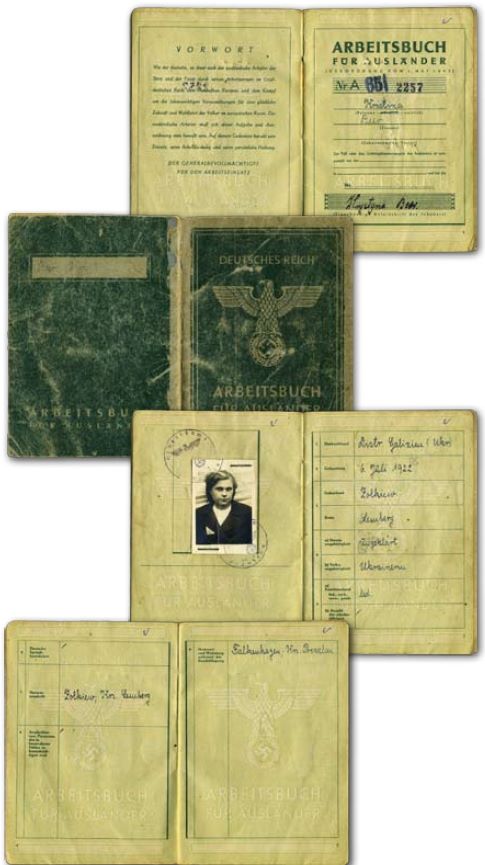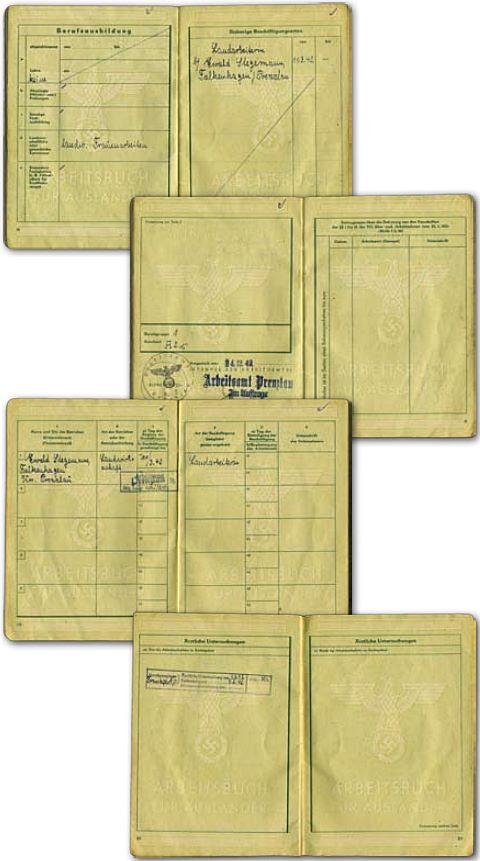“employment record book” was issued by the Third Reich for employed adults, according to the decree of 26 of February of 1935. This proved the development of a totalitarian society in Germany since it shows mandatory employment of the population for military purposes. On the 26 of May of 1935 the German government issued a decree regarding compulsory work (Arbeitspflicht). Three years later, in June of 1938, two new decrees were issued in Germany. One limited the right to change the place of employment; the other allowed the relocation (displacement) of people to work in different regions from where they lived. This was called “service obligation” (Dienstverpflichtung).
As of the 1st of September to revoke an employment contract one had to make an agreement with the Labor Office (Arbeitsamt). The population fit for employment was directed by the local labor offices (Landesarbeitsamtes). In 1943 these offices were turned into district employment offices. It should be noticed that even before the beginning of the war, branches of those offices were ready to be implemented in Poland. So, these labor offices became the first civil administration created by the German in Polish territories.
On the 3rd of September the first one opened in Śląsk (Rybnik). By the end of September there were 70 labor offices (Arbeitsamt) functioning, and one month later it had reached 150. The basic employment legislation was changed, since the people were not free workers anymore, but forced laborers. The legislative changes were progressively implemented by the occupation against the Polish population, but were specially restraining towards the Jewish population. As a consequence, the fundamental principle of Political Legislation was Arbeitszwang employment (obligation to work).
In 1939, in the territories incorporated immediately into the Third Reich there was a registration of the population in the Labor Offices (Arbeitsamts). Separate databases were created: the employed population had Beschäftigungskarte – “employment card” (later Arbeitsbuch) and for the unemployed Meldekarte – “local registration card” or Ausweiskarte. Both the employed and the unemployed had other documents with precise data concerning age, residence and professional qualifications. This data was constantly verified. The labor offices summoned the workers to fill out their payments in the employment card (Beschäftigungskarte), and the employers were required to submit the lists of employees, so that the data could be compared.
Unemployed population was forced to go everyday or every other day to the labor offices, or their branches with their local registration card (Meldekarte). The branches of the labor offices gathered the data and send it to the GG. The Department of Employment which was under the Government Administration, was responsible for the Labor policies.
Arbeitsbuch was a formal document used to register a crossed communication between the three parties : the employer, the employee and the Office of Labor. It consisted of a dozen papers divided into sections, which contained personal data such as address, civil status, if one had children, former and current employment, occupational group, education, former work experience, etc. There were two kinds of Arbeitsbuch. A more detailed type (38 pages), introduced by the aforementioned law of 26 February 1935, was in use prior to September of 1939 as a normal document confirming employment in Germany. During the war it became a document issued for forced laborers. It became a mandatory document for the Poles sent to Germany as force laborers according to the decree of 22 May 1942.


The regulation of 1st of May, 1943 introduced a simplified model of the book (36 pages for foreigners deported to forced labor in the Reich – Arbeitsbuch für Ausländer). In the Free City of Danzig (Pol: Gdansk) the Arbeitsbuch version of 1935 began to be issued from 1938. In this case the Arbeitsbuch had other graphic design: the national symbol of the German Reich was substituted by the arms of the Free City of Danzig. The obligation to possess an employment record book was imposed on Polish territory gradually. It started in October 1939, in Silesia; in July 1942 in Pomerania (Pol: Pomorze) and in Wielkopolska in December 1943. In the regions of the General Government the equivalent to the Arbeitsbuch was Arbeitskarte – “ work card” (regulation of 20 December 1940), modeled on the existing Arbeitsbuch in the Reich. The Arbeitskarte, despite differences in the denomination was the same type of document and was structurally identical to Arbeitsbuch. The Arbeitskarte was successfully gradually introduced in the GG until 1942. First it was issued to the employees of industries which was important for military purposes, and in the end to the administrative personnel. German citizens within the Reich did not possessed a Arbeitskarte but instead a Arbeitsbuch. However, children in primary school, freely employed persons, as well as those employed in fisheries, forestry and agriculture did not have a Arbeitsbuch. The agricultural workers were handled as “resources” and were registered in the database for agricultural workers (Landwirtschaftlische Betriebskartei) in the Labor Offices. The workers were displaced from farm to farm in order to increase the efficiency of the agriculture production. The criteria for the transferences of the workers were based on the size of the farm, the type of production and the number of workers and residents of the farm.
In order to obtain an Arbeitsbuch one had to apply for one. On the first page of the book, issued by the Arbeitsamt was a double number and the first part of this number identified the Arbeitsamt. The second part of the number was the registration-number entitled by the registry of the Office of Labor. Thus we present Arbeitsbuch for foreigners (Arbeitsbuch für Ausländer) of a female deportee which contains the number of employee, “ 65/2257” , where the figure “ 65” is the Labor Office in Prenzlau, and the figure “ 2257” is the personal registration-number of the Arbeitsbuch.


At the commencement of the work the employee handed over the Arbeitsbuch (Arbeitskarte in GG) to the employer who should fill out the date of beginning of work, the type of tasks, residence, and any amendments thereto and the date of the end of the work. The employer should inform the Arbeitsamt about every amendments in the document, and this new data would be added to each worker’s file in the database. If the employee had been working in more than one location, the Arbeitsbuch would be at the first place of employment. During breaks of employment the Arbeitsbuch should be deposited in the Labor Office. It was not allowed to possess two Arbeitsbuch. However this rule did not apply if connecting the card with the GG employment book. In the case of deportation to forced labor outside the GG a normal Arbeitsbuch was issued. In the case of workers deported to Germany, the Arbeitsbuch would remain with the employer, and the whole procedure of deportation was handled by the employer and the Labor Office. In fact, the documents never passed through the forced laborer’s hands.
The documents were only acquired by the forced laborers after the end of the war, when they were free to leave their working places or when the German employers fled the occupied territories. A minimal number of Arbeitsbuch copies survived until today in fairly good conditions. The German wartime did not allow foreign workers to take any documentation regarding their employment when returning home. A special decree was issued on the 18 of November of 1941 regulating this matter for Poles. However Poles living in the areas incorporated into the Reich were exempted from this regulation.